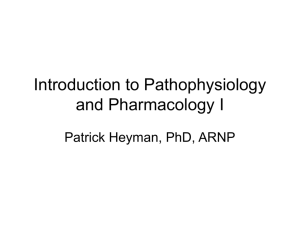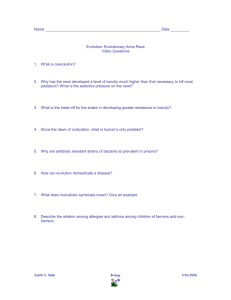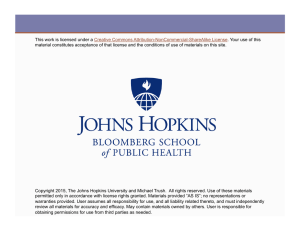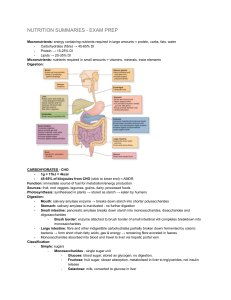Harvard-MIT Division of Health Sciences and Technology HST.151: Principles of Pharmocology
advertisement
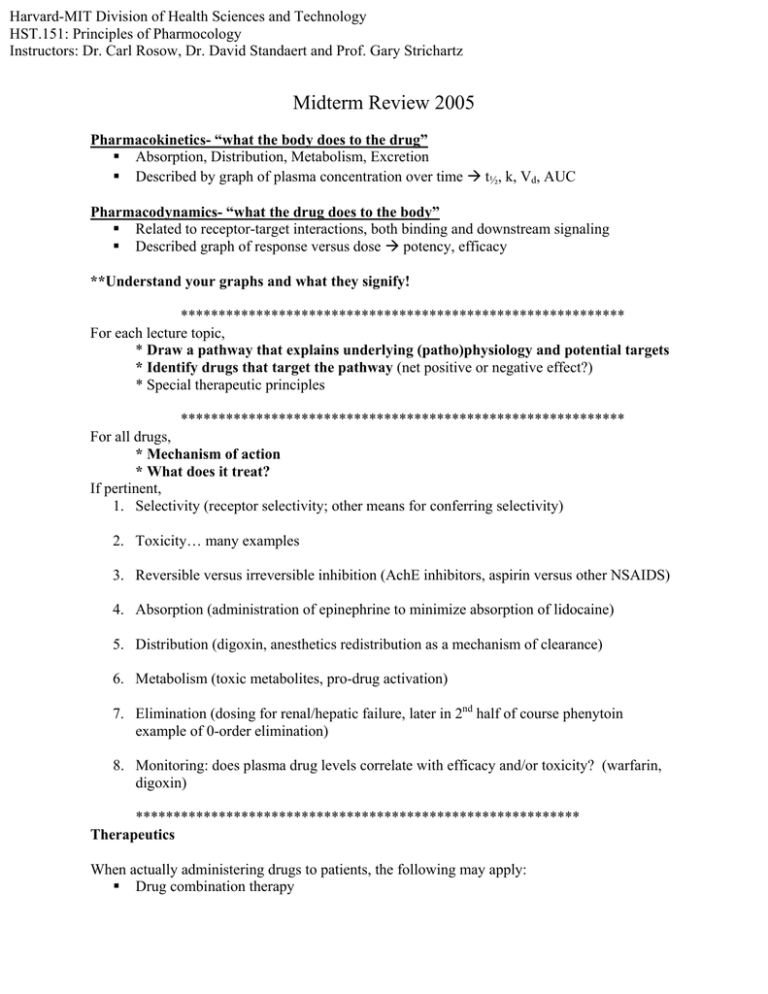
Harvard-MIT Division of Health Sciences and Technology HST.151: Principles of Pharmocology Instructors: Dr. Carl Rosow, Dr. David Standaert and Prof. Gary Strichartz Midterm Review 2005 Pharmacokinetics- “what the body does to the drug” Absorption, Distribution, Metabolism, Excretion Described by graph of plasma concentration over time Æ t½, k, Vd, AUC Pharmacodynamics- “what the drug does to the body” Related to receptor-target interactions, both binding and downstream signaling Described graph of response versus dose Æ potency, efficacy **Understand your graphs and what they signify! *********************************************************** For each lecture topic, * Draw a pathway that explains underlying (patho)physiology and potential targets * Identify drugs that target the pathway (net positive or negative effect?) * Special therapeutic principles *********************************************************** For all drugs, * Mechanism of action * What does it treat? If pertinent, 1. Selectivity (receptor selectivity; other means for conferring selectivity) 2. Toxicity… many examples 3. Reversible versus irreversible inhibition (AchE inhibitors, aspirin versus other NSAIDS) 4. Absorption (administration of epinephrine to minimize absorption of lidocaine) 5. Distribution (digoxin, anesthetics redistribution as a mechanism of clearance) 6. Metabolism (toxic metabolites, pro-drug activation) 7. Elimination (dosing for renal/hepatic failure, later in 2nd half of course phenytoin example of 0-order elimination) 8. Monitoring: does plasma drug levels correlate with efficacy and/or toxicity? (warfarin, digoxin) *********************************************************** Therapeutics When actually administering drugs to patients, the following may apply: Drug combination therapy Examples: examples to come in antibiotics Drug interactions, especially in drug metabolism Examples: Effect on warfarin metabolism of P450 inducers and inhibitors; MAO inhibitors and tyramine Mode of administration Examples: Inhalation of asthma drugs; topical administration of glaucoma drugs Order of administration Examples: thioamides before iodides in Rx of hyperthyroidism; α-blocker before βblocker in Rx of pheochromocytoma; for gout if high uric acid load, allopurinol to stop synthesis before probenicid Drug resistance Examples: many in antibiotics and chemotherapeutics next section of course Think of examples when these concepts might be important as you review. *********************************************************** Case presentations Anticholinesterase Direct versus indirect agonists (targets receptor directly versus affects binding/signaling) Symptoms/signs and treatment of toxicity Anticoagulation Concept of therapeutic window, specifically narrow therapeutic window of warfarin Æ need for close monitoring and attention to anything that would effect drug levels Drug interactions, both inducer and inhibitor of drug metabolism Sulfasalazine Use of pro-drug sulfapyridine Side effects of metabolized pro-drug Decreased bioavailability and usefulness in therapeutic effect Pheochromocytoma Acute versus long-term treatment Order of treatment: α-blocker then β-blocker Asthma Strategy for treatment: bronchodilation versus anti-inflammatory; acute versus chronic Toxicity associated with theophylline Poison Control Mechanism for antidote Glaucoma Open vs closed angle glaucoma and treatment Mechanism of Rx and drugs: 1) reduce fluid production and 2) increase drainage Pharmacogenetics CYP2D6 polymorphism Drug metabolism: active Æ inactive, pro-drug Æ active, active Æ toxic Thyroid Disease Thyroid hormone biosynthesis and therapeutic targets Order of administration: thioamides before iodide Cocaine Mechanism of action: NE reuptake inhibition, local anesthetic, DA reuptake inhibition (CNS) CV effects: coronary vasospasm, sympathetic overload Gout Etiology of uric acid overload (“wine and meat,” tumor lysis syndrome, drugs, etc) and pathophysiology of crystal deposition and inflammation Acute anti-inflammatory therapy versus chronic reversal of hyperuricemia Toxicity of colchicines *********************************************************** Lecture Topics- Special Notes Dose-Response/ Drug-Receptor Interactions- Strichartz 1. Effect of spare receptors on Kap of competitive agonist? Antagonist? 2. Full agonists vs partial agonists vs antagonists 3. Reversible vs irreversible antagonist (effect on dose response curves) Pharmacokinetics- Walsh 1. Be able to calculate bioavailability 2. Effect of absorption, distribution, and clearance on therapeutic efficacy Drug delivery- Langer 1. Sustained vs controlled vs targeted release (how to achieve) 2. When is each type of release kinetics desired? Drug Metabolism/ Pharmacogenetics- Dershwitz 1. G6PD deficiency and mechanism for inducing adverse reaction 2. Pseudocholinesterase 3. Porphyria 4. Fast vs slow acetylators Autonomic Pharmacology- Stichartz/ Rosow 1. Difference between depolarizing and non-depolarizing muscle relaxants (fasciculations, fade, reversal of block with AchE inhibitors, post-tetanic potentiation) 2. Difference between nicotinic vs muscarinic receptors 3. How do nicotinic receptors work (aka Na channel) 4. G-protein coupled muscarinic receptors: which are stimulatory, which inhibitory 5. Mechanisms for down-regulating β-adrenergic signaling (tachyphylaxis, receptor downregulation, receptor endocytosis, desensitivation via phosphorylation) 6. Advantage of selective α1-receptor antagonist over nonseletive α-blocker Local Anesthetics- Strichartz 1. Effect of protonated drugs on membrane permeability and Na channel binding 2. Use-dependent blockade 3. Why bicarbonate and epinephrine co-administered with lidocaine Anti-dysrhythmics- Ruskin 1. Effect of different classes on myocardial action potential and automaticity 2. Toxicity of Class III (Torsades de pointes) from prolonged QT 3. Selectivity of class I and IV from use-dependent blockade of channels 4. Acute vs long-term management of arrhythmias Anti-inflammatory drugs- Weinblatt 1. NSAID toxicity 2. Aspirin effect on platelets (why? Because of irreversible inhibition!) Drugs for CHF- Baker 1. Which drug classes proven to have mortality benefit? 2. Rationale for using β-agonists in short-term and β-antagonists in long-term management Drugs for hypertension- Baker 1. Different classes of drugs, diuretics, sympatholytics, vasodilators, rennin-angiotensin blockers and mechanism for lowering pressures 2. Combining different classes for synergistic effect Lipid-lowering drugs- Lees 1. Effect of statins on LDL receptors and ultimately level of plasma LDL 2. Niacin toxicity
